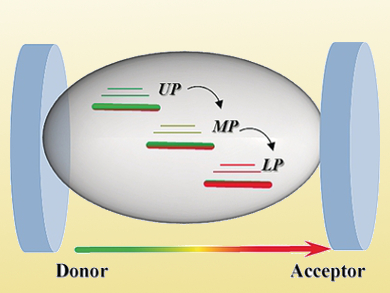Non-radiative energy transfer in molecules has been extensively studied and typically involves either Coulombic interactions (Förster-type) or electronic exchange. Thomas Ebbesen and colleagues, Institut de Science et d’Ingénierie Supramoléculaires, Strasbourg, France, have found direct evidence of enhanced non-radiative energy transfer mediated by hybrid light-matter states.
The team used self-organized J-aggregates of cyanines (which are good Förster donor–acceptor pairs) and studied their energy-transfer dynamics when incorporated into optical cavities. Fluorescence excitation spectroscopy and femtosecond pump-probe measurements showed that the energy transfer is highly enhanced when both the donor and acceptor form light-matter hybrid states with the cavity vacuum field. The resulting delocalized hybrid states connect the donor and acceptor molecules, playing the role of a bridge to enhance the rate of energy transfer by at least a factor of seven compared to outside the cavity.
According to the researchers, this demonstration of enhanced energy transfer through cascades of hybrid light-matter states could have fundamental implications for coherent energy transport and light harvesting. This finding could also be beneficial for solar energy conversion and light-matter strong coupling could impact molecular and materials science.
- Non-Radiative Energy Transfer Mediated by Hybrid Light-Matter States,
Xiaolan Zhong, Thibault Chervy, Shaojun Wang, Jino George, Anoop Thomas, James A. Hutchison, Eloise Devaux, Cyriaque Genet, Thomas W. Ebbesen,
Angew. Chem. Int. Ed. 2016, 55, 6202–6206.
DOI: 10.1002/anie.201600428




